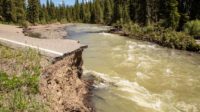Sections of Yellowstone National Park’s road network have been severely damaged and–in some locations, obliterated–following record flooding earlier this week.
According to a National Park Service statement, the hardest hit areas are in the Wyoming park’s northern section, where aerial surveys revealed major damage to multiple sections of road between the park’s north and northeast entrances. Electric, water and wastewater systems in those areas have also been disrupted by the flooding.
The Park Service has yet to determine the full extent of damage and repair needs but said it is “probable” some road sections will not reopen this season.
Although damage appears lighter along the park’s southern loop road, the Park Service has closed the park temporarily pending a full assessment of roads, bridges and wastewater treatment facilities. More than 10,000 visitors staying at the park’s lodges and campgrounds were evacuated, along with five known groups of backcountry campers.
The Park Service says no deaths or injuries resulting from the flooding have been recorded.
The National Weather Service estimates that up to 5 in. of rain fell across parts of southern Montana and northern Wyoming during June 10-13, combined with 2 in. to 5 in. of concurrent snow melt to bring the Yellowstone, Stillwater and Clarks Fork Rivers to record levels.
At Corwin Spring, Mont., just north of the park’s North entrance, the Yellowstone River crested at 13.88 ft on Monday, more than two feet higher than the previous record set in 1918. Residents and evacuees in the nearby town of Gardiner, Mont., were stranded until receding floodwaters on June 14 allowed U.S. Highway 89 to reopen.
Further downstream in Billings, Mont., the National Weather Service reported on June 15 that the Yellowstone River had yet to drop from the major flooding level of more than 16 ft set the previous day. The U.S. Geological Survey recorded flows of 83,100 cfs at midday Wednesday, more than three times the median rate for this time of year.
More flooding could be on the way, with the region’s weather forecast calling for more rain over the next few days, plus high temperatures that will affect high mountain snowpacks.




Post a comment to this article
Report Abusive Comment